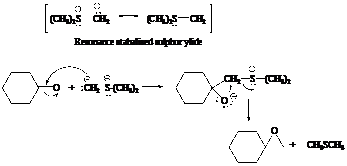
Concept explainers
Practice Problem F.1
Show how you might use a sulfur ylide to prepare

Interpretation:
The sulfur ylide required for the preparation of the given compounds is to be shown.
Concept introduction:
Sulphur ylide acts as the nucleophile and attacks the carbonyl carbon of aldehydes and ketones.
The intermediate formed in the reaction of sulphur ylide and carbonyl carbon is generally an epoxide rather than an alkene.
Answer to Problem 1PP
Solution:
The reactant used are:

The reactant used are:

Explanation of Solution
a)

In the formation of the given product, the ketone used is cyclo hexanone. In the first step, sulfur ylide acts as a nucleophile ( group of sulfur ylide) and attacks the carbonyl carbon of cyclo hexanone. After this,
group of sulfur ylide) and attacks the carbonyl carbon of cyclo hexanone. After this,  group is removed from the sulfur ylide, which results in the formation of the epoxy ring. The whole reaction can be shown as follows:
group is removed from the sulfur ylide, which results in the formation of the epoxy ring. The whole reaction can be shown as follows:

Hence, cyclohexane is used in combination with sulfur ylide to form the given compound.
b)

In the formation of the given product, the ketone used is acetone. In the first step, sulfur ylide acts as a nucleophile ( group of sulfur ylide) and attacks the carbonyl carbon of the acetone. After this,
group of sulfur ylide) and attacks the carbonyl carbon of the acetone. After this,  group is removed from the sulfur ylide which results in the formation of the epoxy ring.
group is removed from the sulfur ylide which results in the formation of the epoxy ring.
The whole reaction can be shown as follows:

Hence, acetone is used in combination with sulfur ylide to form the given compound.
Want to see more full solutions like this?
Chapter F Solutions
Organic Chemistry
Additional Science Textbook Solutions
Biochemistry: Concepts and Connections (2nd Edition)
Fundamentals Of Thermodynamics
Microbiology: An Introduction
Applications and Investigations in Earth Science (9th Edition)
Introductory Chemistry (6th Edition)
Human Physiology: An Integrated Approach (8th Edition)
- 8:16 PM Sun Mar 30 K Draw the major product of this reaction. Ignore inorganic byproducts. Proble 1. CH3MgBr 2. H3O+ F Drawingarrow_forwardо но оarrow_forwardName the major organic product of the following action of 4-chloro-4-methyl-1-pentanol in neutral pollution 10+ Now the product. The product has a molecular formula f b. In a singly hain, the starting, material again converts into a secule with the molecular kormula CIO. but with comply Draw the major organic structure inhalationarrow_forward
- Macmillan Learning Alcohols can be oxidized by chromic acid derivatives. One such reagent is pyridinium chlorochromate, (C,H,NH*)(CICTO3), commonly known as PCC. Draw the proposed (neutral) intermediate and the organic product in the oxidation of 1-butanol by PCC when carried out in an anhydrous solvent such as CH₂C₁₂. PCC Intermediate OH CH2Cl2 Draw the intermediate. Select Draw Templates More с H Cr о Product Draw the product. Erase Select Draw Templates More H о Erasearrow_forwardIf I have 1-bromopropene, to obtain compound A, I have to add NaOH and another compound. Indicate which compound that would be. A C6H5 CH3arrow_forwardProvide the reagents for the following reactions.arrow_forward
- If I have 1-bromopropene, to obtain compound Z, I have to add two compounds A1 and A2. Indicate which compounds are needed. P(C6H5)3arrow_forwardDraw the major product of this reaction. Ignore inorganic byproducts. Assume that the water side product is continuously removed to drive the reaction toward products. O CH3CH2NH2, TSOH Select to Draw >arrow_forwardPredict the major organic product(s) for the following reaction.arrow_forward
- Predict the major organic product(s) for the following reactions.arrow_forwardProvide the complete mechanism for the reactions below. You must include appropriate arrows,intermediates, and formal charges.arrow_forwardIndicate the products obtained by reacting fluorobenzene with a sulfonitric mixture.arrow_forward
 Organic Chemistry: A Guided InquiryChemistryISBN:9780618974122Author:Andrei StraumanisPublisher:Cengage Learning
Organic Chemistry: A Guided InquiryChemistryISBN:9780618974122Author:Andrei StraumanisPublisher:Cengage Learning Macroscale and Microscale Organic ExperimentsChemistryISBN:9781305577190Author:Kenneth L. Williamson, Katherine M. MastersPublisher:Brooks Cole
Macroscale and Microscale Organic ExperimentsChemistryISBN:9781305577190Author:Kenneth L. Williamson, Katherine M. MastersPublisher:Brooks Cole

